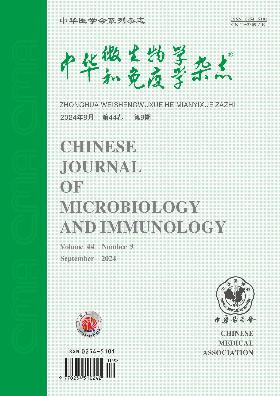重组酶介导的体外快速构建编码EGFP的具有复制能力的人14型腺病毒载体
Q4 Immunology and Microbiology
引用次数: 0
摘要
目的利用体外同源重组技术快速高效地构建具有复制能力的人重组腺病毒14型增强型绿色荧光蛋白(rAd14-EGFP)载体。方法采用同源重组法在大肠杆菌BJ5183感受态细胞中构建骨架质粒pBRAd14。将质粒线性化后转染AD293细胞,以挽救Ad14。利用重组酶Exnase在体外构建穿梭质粒pSK14-EGFP,对4个片段进行同源重组。重叠序列为15 ~ 20 bp。将PCR生成的Ad14 E3L片段、EGFP基因和Ad14 E3R片段3个外源片段同时克隆到质粒pBluescriptⅡSK(-)中。以穿梭质粒pSK14-EGFP为模板,将双酶切获得的pBRAd14质粒27kb片段与PCR扩增的Ad14 E3L-EGFP-Ad14 E3R片段进行体外同源重组,构建重组质粒pBRAd14- egfp。将质粒pBRAd14-EGFP线性化后转染细胞,得到病毒载体rAd14-EGFP,用于免疫小鼠,检测诱导的免疫应答。结果成功构建了表达EGFP的增殖能力强的e3缺失腺病毒载体rAd14-EGFP。与Ad14相比,该载体的细胞内增殖特性和免疫原性无显著差异。结论利用商业重组酶Exnase进行体外同源重组是一种快速、高效、准确构建腺病毒载体的方法。关键词:人腺病毒14型;重组酶Exnase;体外同源重组;腺病毒载体本文章由计算机程序翻译,如有差异,请以英文原文为准。
Recombinase-mediated in vitro rapid construction of replication-competent human adenovirus type 14 vector encoding EGFP
Objective
To rapidly and efficiently construct a replication-competent human recombinant adenovirus type 14 vector expressing enhanced green fluorescence protein (rAd14-EGFP) using in vitro homologous recombination.
Methods
The skeleton plasmid pBRAd14 was constructed using homologous recombination in Escherichia coli (E.coli) BJ5183 competent cells. The plamid was linearized and transfected into AD293 cells to rescue Ad14. Exnase, a recombinase, was used to construct the shuttle plasmid pSK14-EGFP in vitro using homologous recombination among four fragments. The overlapping sequence was 15-20 bp. Three exogenous fragments generated with PCR including Ad14 E3L fragment, EGFP gene and Ad14 E3R fragment were cloned into the plasmid pBluescript Ⅱ SK(-) simultaneously. Recombinant plasmid pBRAd14-EGFP was constructed by in vitro homologous recombination between 27 kb fragment of plasmid pBRAd14 obtained through double digestion and Ad14 E3L-EGFP-Ad14 E3R fragment amplified by PCR using the shuttle plasmid pSK14-EGFP as template. The plasmid pBRAd14-EGFP was linearized and transfected into cells to obtain the viral vector rAd14-EGFP, which was then used to immunize mice to detect the induced immune responses.
Results
A replication-competent E3-deleted adenovirus vector rAd14-EGFP expressing EGFP was successfully constructed. Intracellular proliferation properties and immunogenicity of the vector were no significantly differences compared with those of Ad14.
Conclusions
In vitro homologous recombination using the commercial recombinase Exnase can be a rapid, efficient and accurate method to construct adenoviral vector.
Key words:
Human adenovirus type 14; Recombinase Exnase; In vitro homologous recombination; Adenovirus vector
求助全文
通过发布文献求助,成功后即可免费获取论文全文。
去求助
来源期刊

中华微生物学和免疫学杂志
Immunology and Microbiology-Virology
CiteScore
0.50
自引率
0.00%
发文量
6906
期刊介绍:
Chinese Journal of Microbiology and Immunology established in 1981. It is one of the series of journal sponsored by Chinese Medical Association. The aim of this journal is to spread and exchange the scientific achievements and practical experience in order to promote the development of medical microbiology and immunology. Its main contents comprise academic thesis, brief reports, reviews, summaries, news of meetings, book reviews and trends of home and abroad in this field. The distinguishing feature of the journal is to give the priority to the reports on the research of basic theory, and take account of the reports on clinical and practical skills.
 求助内容:
求助内容: 应助结果提醒方式:
应助结果提醒方式:


